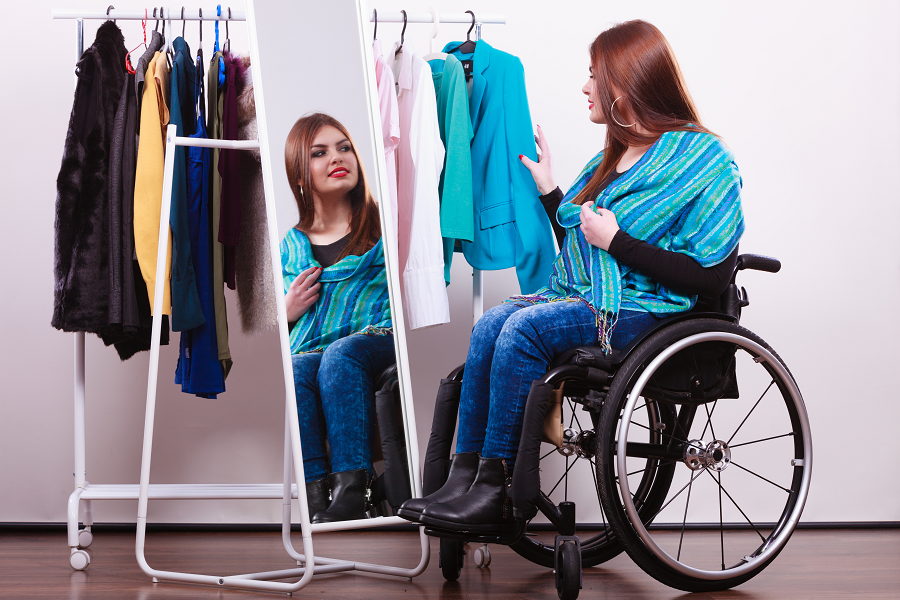What is adaptive fashion?

If you have a disability or know someone who does, you might have heard of adaptive fashion. It’s widely touted as being inclusive for people with disabilities, but what exactly is adaptive fashion?
What is adaptive clothing?
In its most widely accepted definition, adaptive clothing refers to garments that are designed for people with disabilities. Often, the design of this clothing is created with a certain disability or type of disability in mind. These clothes might look slightly different to non-adaptive clothes, but they're made to help disabled people to dress with ease. As well as adaptations designed for the wearer, clothes can also be adapted for carers. This is especially useful for disabled parents and caregivers.
However, adaptive fashion doesn’t only refer to specially designed garments. In some cases, the term can cover the way products are sold. Some amputees might only need one shoe or one glove, so being able to buy them as singles rather than pairs is useful. It's also far less wasteful.
Moreover, there is a lot to be said for incidental adaptive clothes. These are clothes that have been designed for the wider public rather than disabled individuals. Fortunately, they often have features which can make them easier to wear. This type of adaptive clothing tends to be the least expensive, as it has a much wider target market.
Whether the clothes were designed for disabilities or not, adaptive fashion is all about making disabled lives easier. There are lots of different types of disability out there, and not every kind of adaptive garment will be useful to everyone. However, the more brands start to offer adaptive clothing, the easier it will become to find the right clothing for you.
What are adaptive clothes?
If you’re still not sure what adaptive fashion entails, it might help to consider some examples. For instance, a person who uses a wheelchair for long periods of time might buy specially designed trousers that have a higher waist in the back. Trousers tend to ride lower in the rear when you’re sitting down, so that extra coverage will help to keep the person warmer and maintain their dignity. Alternatively, if you use an ostomy bag, for example, you can get tops that have openings specially designed to allow this access.
Similarly, a parent who has arthritis or a similar condition which affects their dexterity might struggle to do up the buttons on a babygrow. An adaptive fashion brand might offer babygrows that use hook and loop tape rather than buttons. This can help to make it easier for parents to dress their babies.
As for clothing that is incidentally disability-friendly, there are lots of options available. If you find buttons and zips difficult, pull-on clothes can be a great help as there is nothing to fasten. Hook and loop tape shoes are reasonably common, as are zip-up versions, so if you can’t manage laces, you can still find yourself a great pair of shoes.
You can also find that regular clothing can be helpful as an additional item of clothing. For example, wheelchair users and people who use walking sticks can often find the constant pressure chafes their hands. In these circumstances, gloves can help to protect the hands and reduce pain.
Why is adaptive clothing important?
If you’ve never used adaptive clothing before, you might not be aware of all the ways it can improve quality of life for a person with disabilities. Below are some of the most important benefits of adaptive clothing.
Firstly, adaptive clothing can help people to feel more dignified. In cases where access is needed to ostomy bags, for example, adapted clothing can make it easier to be discreet. It can also mean you don't have to take off your clothing to get access. Similarly, if you have dexterity issues, clothes that offer hook and loop tape can mean that tremors or stiffness aren’t as obvious to passers-by. This can help you to feel less noticeable, which can lead to feeling more comfortable and confident.
Adaptive fashion can also potentially broaden your horizons. Where you might have once felt unable to go out for long periods of time because your clothes made things more complicated, adaptive clothing offers solutions that can allow you to do things you previously held back from.
Whether you choose specially designed adaptive fashion pieces or take advantage of the helpful aspects of non-designed clothing, adaptive clothing isn’t a one-and-done measure to make all aspects of disabled living easier. However, it can be a brilliant way to boost your confidence while assisting with some of the little things that get in your way. Why not take a look at your wardrobe today and find out if adaptive clothing could help you?
Copyright © 2025 Chums
PayPal Representative Example:
Representative 23.9% APR (variable) Purchase interest rate 23.9% p.a. (variable) Assumed Credit limit £1,200. PayPal Credit and PayPal Pay in 3 are trading names of PayPal UK Ltd, 5 Fleet Place, London, United Kingdom, EC4M 7RD. Terms and conditions apply. Credit subject to status, UK residents only, Chums Ltd acts as a broker and offers finance from a restricted range of finance providers. PayPal Pay in 3 is not regulated by the Financial Conduct Authority. Pay in 3 eligibility is subject to status and approval. 18+. UK residents only. Pay in 3 is a form of credit. Check if affordable and how you will repay. May make other borrowing more difficult or expensive. See product terms for more details.



